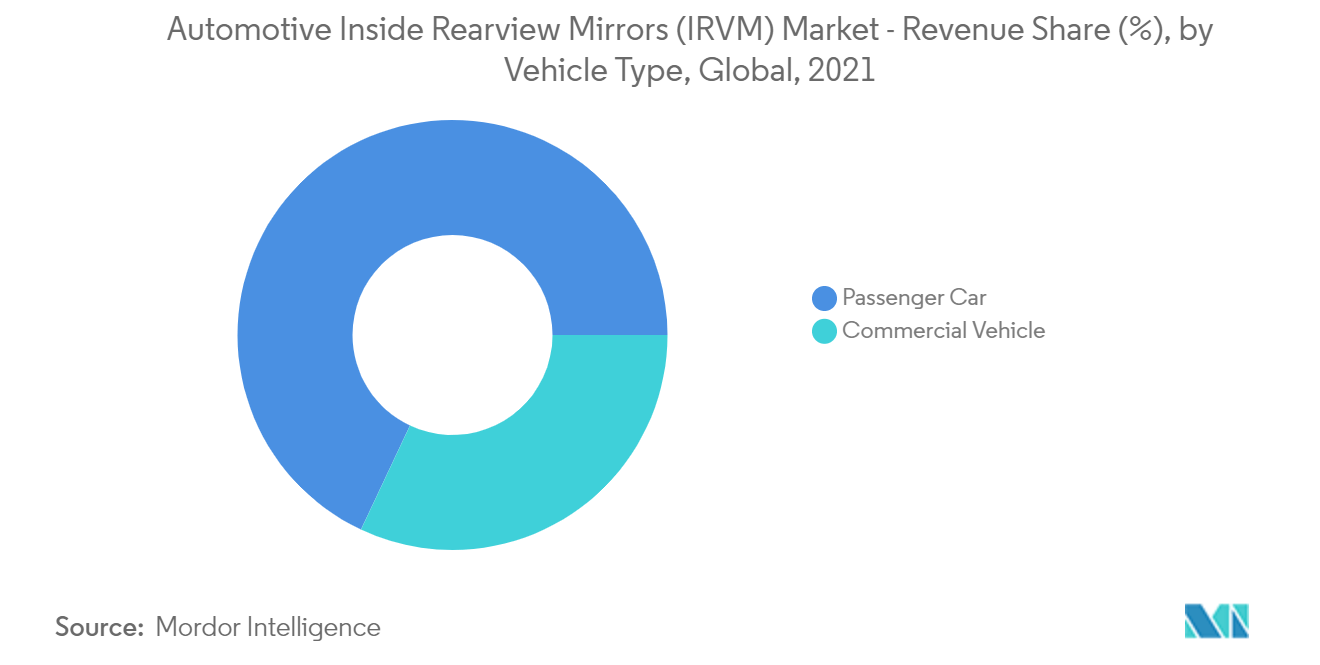Market Trends of Automotive Inside Rearview Mirrors (IRVM) Industry
This section covers the major market trends shaping the Automotive Inside Rearview Mirrors Market according to our research experts:
Passenger Car Segment Likely to Hold Significant Share in the Market
The Passenger car segment of the market during the forecast period to grow at faster pace owing to rising vehicle production and growing focus of jey OEMs on launching innovative products to attract wide range of consumers in wake of rising vehicle sales across major regions in the world. For instance, In 2021, the global car sales were around 66.7 Million, which in 2020 were 63.8 Million. The global pandemic impacted economic activities all around the world including car sales the globe, and strict lockdowns were enforced in several countries to contain the spread of the virus. Owing to this the number of cars sold in 2020 was 14.8% lower than compared in 2019. But with life returning to normalcy, the number of cars sold globally has increased which will aid the automotive IRVM market to grow in the forecast period.
Owing to the increase in the demand for passenger cars and the growing awareness of electric mobility, major players are looking forward to electrifying their present fleet. For instance,
- In March 2022, Ford Motors announced to include three all-electric passenger vehicles in Europe by the end of 2024 and set a target to sell more than 600,000 electric vehicles annually by 2026 in the Europe region.
- In January 2022, General Motors announced considering investing more than USD 4 billion in two Michigan factories to increase its electric car manufacturing capacity. GM and LG Energy Solution have proposed constructing a USD 2.5 billion battery facility in Lansing.
With rising sales of the passenger car segment, demand for IRVM is witnessing promising growth. Nowadays, all the id-segment and luxury passenger cars are equipped with advanced IRVM which has posed technological dominance over the market. For instance,
- In August 2022, Audi India has introduced its new Q3 which has adopted several new technologies to look at. Audi has added frameless auto dimming IRVM and parking aid plus with rear view camera, which shall improve the driver safety and comfort apart from other added features in complete Q3.
- In August 2022, after witnessing impressive sales on Tata Punch, Tata Group is announced that ist going to launch a Creta segment mid-size SUV named Blackbird next year which shall encompass added features. The car shall be equipped with advance digital instrument console, auto-dimming IRVM, automatic climate control, electrically operated ORVMs and may more other features.
The automotive inside rear-view mirror market is facing tough competition from new camera technologies with are coming in the passenger car segment. Leading automotive OEMs and interior rear-view manufacturers are integrating cameras with conventional mirrors to provide a better view of the drivers. In certain situations, the rear view of the vehicle through a mirror is blocked and causes hindrance to the driver's view.
Thus, camera integration with the rear-view mirror system has been the best solution so far in the automotive industry. Considering these developments and factors with rising passenger car sales, demand for IRVM is expected to witness a high growth rate in the forecast period.

Asia-Pacific Region Anticipated to Grow at Significant Level During the Forecast Period
The Asia-Pacific region accounts for the largest share in the market owing to the availability of low-cost raw materials, cheap labour, and increasing government initiatives toward local manufacturing. In the region, China is one of the largest producers and consumers of electric vehicles as well as increasing demand for passenger car sales in the countries like India, Japan, South Korea, etc., are likely to boost the demand for inside rear-view mirrors in the automotive industry.
China, which is the largest electric vehicle market in the world, has been backed up by generous support from the government. China has extended the incentives related to the purchase of new energy vehicles (NEVs) till 2022. Asia-Pacific region is aggressively supporting the electrical vehicle adoption. For instance,
- In January 2020, Tesla Motors inaugurated a USD 2 billion facility in Shanghai that was assembling nearly 3000 cars per week in March 2020, when all the other global facilities of the electric vehicle giant were shut down due to the COVID-19 pandemic.
- During the end of FY21, Hyundai sold 313, 926 cars globally in March. The sales statistics stood at a drop of 17% compared to previous years. The sales were even less than Q1 2021. Moreover, Hyundai observed that its automotive segment witnessed a sharp rise with almost doubled sales figures for its all-electric cars. This in turn makes the sales figure for its BEV to stood at 11,447 units with a rise of 105%. In addition, the plug-in electric cars increased to 14,693 units to 58% year and year growth.
Governments and administrations in developing and untapped markets are spending a major portion of their wealth on improving transportation and its safety. This will result in the sales growth of vehicles and also calls for additional features to suit the needs of vehicle safety. With IRVM being highly dependent of sales of the vehicles, Asia-pacific has been leading the vehicles sales across the globe making its epicentre for IRVM adoption. Considering these aspects demand for IRVM is expected to witness high growth rate during the forecast period.


